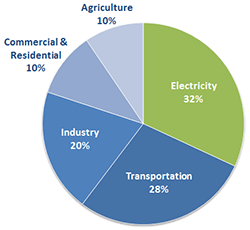MAJOR INDIRECT BENEFITS OF OBAMA’S CLIMATE PLAN THAT COULD SAVE THE WORLD (VIDEO)
President Obama spoke on Monday on his plan to use the Environmental Protection Agency to pressure states to close high-carbon power plants and reduce CO2 emissions by 32% below 2005 levels by 2030. The US Supreme Court has ruled that carbon dioxide is a form of pollution and so regulating it falls under the EPA’s purview.
This part of his plan is in my view the least interesting thing about it. Because Obama uses a 2005 benchmark, the historical height of our carbon emissions when the US put up 6 billion tons of CO2 a year, it will be fairly easy to meet his unambitious goal of reducing CO2 by a third from that high mark. Just a bad economy since 2008 has already caused US emissions to fall to 5.4 billion tons annually. And, the electricity generation sector only accounts for 32 percent of carbon produced by the US. So the reductions come in only about 2 billion a year of these emissions. The US has to get those 2 billion down to 1.267 billion. The total annual reduction by 2030 is therefore just .73 tons per annum. We’re still putting out over 5 billion tons a year and will go on doing nearly that through 2030. Obama’s plan would get us down to 4.67 billion tons a year. eh.
Let’s be clear. We need to be at net carbon zero by 2030. We don’t need to cut out less than a ton of emissions. We need to cut out almost all of our 5.4 billion tons.
So if we only focused on this relatively minor reduction in over-all CO2 emissions, which can largely be achieved by closing down some very dirty coal plants, I think we would miss the bigger picture.
Our best hope for carbon reduction is steep price drops in the cost of generating electricity by wind and solar; in the cost of installing wind turbines and solar panels; and in the cost of storing energy in batteries. If those price drops are achieved, we’ll head toward vast reductions in emissions regardless of what the EPA does. No one is going to pay 12 cents a kilowatt hour for electricity (our current national average) if it can be had for 2 cents a kilowatt hour, all other things being equal.
So here are some indirect benefits of Obama’s plan.
His mandate of a 32 percent reduction in CO2 is a concrete goal that all states and all utilities can reasonably meet. States and utilities have reason not to reduce CO2. Some states have a coal lobby or are invested in natural gas. Utilities are afraid that rooftop solar panels plus better, cheaper battery storage could make them unnecessary. There is always an expense in putting in a new energy plant– why do it if the old, black smoke-belching coal plant can still turn steam turbines and the construction costs were sunk decades ago? This plan makes them do what otherwise they would likely choose not to.
That the Federal goal exists and is mandatory will begin working into American consciousness and law that CO2 emissions are a tort, and good faith efforts must be made to ameliorate the damage being caused. American law is all about private property, and damaging property is always actionable. Well, nothing damages property like climate change.
If court judges and juries begin accepting that putting carbon into the atmosphere is injurious, the way tobacco smoking is, lawsuits in the courts could begin prevailing. The EPA won’t have to close coal plants if consumers can bankrupt them with class action lawsuits.
Swanson’s law states that with every doubling of orders for solar panels, their cost falls by 20%. Since Obama’s EPA mandate requires states to replace high-carbon energy sources like coal and natural gas with virtually no-carbon ones like wind and solar, the utilities will be ordering *a lot* of solar panels. Could orders double annually? It is already crazy not to put solar panels on your roof if you are a home owner and are going to be in your house 10 years or more. You are right now costing yourself money. But if the panels get 20% cheaper every year for five years then it will be truly insane not to put them up. And of course if this is obvious to home owners it will also be obvious to industry. Walmart and Ikea are already going in this direction, and neither could be accused of not knowing how to make and save money.
Obama’s plan has $4 billion in government and private business commitments to research and development on clean energy. That is a lot of R&D money. In addition, the requirement of a 30% reduction in carbon at electricity plants will cause energy firms and states to pitch in even more for research. We are probably on the brink of huge breakthroughs in solar panels. New materials such as graphene or perovskites would be massively cheaper than silicon. Ways of increasing efficiency will also be found.
Rapid falls in price of materials and installation because of mass production will produce a technological disruption, as Tony Seba of Stanford calls it. There are tipping points in technology adoption such that sometimes old technologies are superseded with lightning speed. Seba shows a photo of the Easter Day parade down Fifth Avenue in New York City in 1900, and it is almost all horse and carriages with one automobile.
He shows another slide, of the same parade in 1913 after the Model T came out. It is all automobiles.
So the reduction by .7 tons a year of carbon dioxide emissions from power plants by 2030 is not the story here. It is the technological and marketing side effects of that mandate that matter. Government regulation, certainly on this scale, won’t solve the problem in and of itself. But government steps that encourage business and consumers to take millions of consequential decisions are essential. The CO2 reduction mandate functions as a sort of carbon tax for states and utilities.
The big story here, then, is that Obama is accelerating what could be (if it is not sabotaged) a vast technological disruption. The old horse and buggy of coal plants and fracking and natural gas could well disappear far more rapidly than most analysts now anticipate. But if the Koch brothers and Big Coal, Big Oil, Big Gas have their way, we’ll go on belching noxious gases into our fragile atmosphere and leave our grandchildren far more likely to be drowned or scorched.










Follow Us!